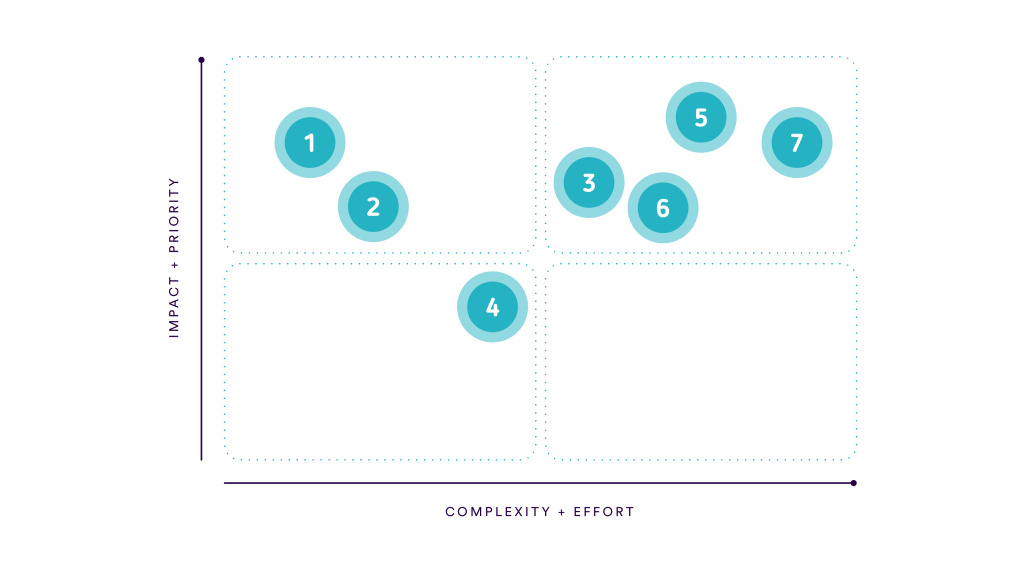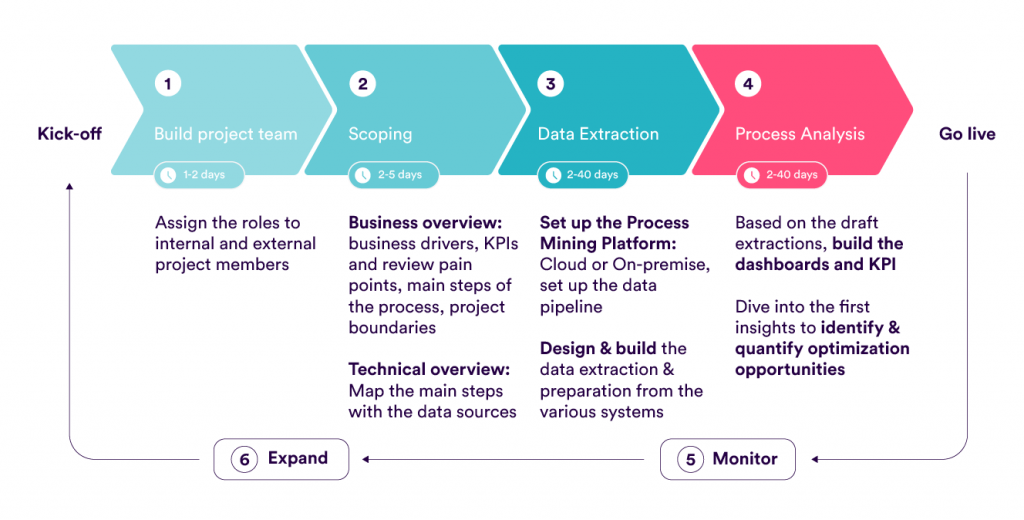With the increasing complexity of operations and processes in companies, Process Mining (PM) has emerged as a significant solution to help gain process intelligence and identify bottlenecks for process improvement. In a previous article, we introduced the core principles of Process Mining. Now, we’re taking it a step further and explaining how to successfully start a Process Mining initiative and what the key turning points are on this journey.
What leads to a Process Mining initiative
Let’s explore the three most common reasons why organizations embark on Process Mining projects:
- First and foremost, an organization may launch a Process Mining initiative to address difficulties with the execution of a critical business process. These difficulties may include extra cost, lack of productivity, lack of transparency, compliance issues, and more. In such cases, Process Mining can be used as a standalone process discovery tool to identify the root causes of these issues and develop solutions to address them.
- Another approach is to launch a larger initiative that spans multiple departments and aims to discover and monitor business processes across the organization. This can provide a holistic view of how processes are being executed, identify inefficiencies, and help to develop best practices that can be shared across the organization.
- Finally, Process Mining can be integrated into a Hyperautomation initiative, which includes a wider platform of outcome-driven automation technologies such as Robotic Process Automation (RPA), Intelligent Document Processing (IDP), Workflows (BPM/BPA), Low Code, and more. By combining these technologies, organizations can achieve a higher level of process maturity and optimize their operations to a greater extent.
While these 3 approaches may differ in scope and ambition at launch, they all have the potential to lead to a comprehensive Hyperautomation initiative that can transform an organization’s entire ecosystem. So whether you’re looking to address specific process difficulties, monitor processes across your organization, or achieve a higher level of process maturity through Hyperautomation, Process Mining can be an essential tool for achieving your goals.
Process selection and prioritization
The first step of a Process Mining initiative is to evaluate the opportunity to use this tool for your business processes. Even if you’re focusing on improving a single process, it’s recommended to go through this step to estimate what business value Process Mining can provide. For organizations targeting several processes, an Agile approach is usually the best one, helping to prioritize processes and tackle them one by one. To select and prioritize processes and potential use cases, there are several key criteria to consider:
- Strategic relevance: Is the process critical for the organization? What’s its importance in terms of financials, revenue, or costs? Are there any regulations that the organization must comply with for this process?
- Optimization potential: How frequently is this process is executed each year? Have any issues or gaps already been identified?
- Technical feasibility: Does each step of the process leave a digital footprint? How many systems are involved? Is there a unique identifier for the instance throughout its execution?
- Sponsorship: Are the process owner and stakeholders available and involved?

Getting Started with Process Mining in 6 steps
Conducting a thorough evaluation of pain points and challenges, as well as strategic initiatives where Process Mining would bring value, is essential during this phase. Defining KPIs and required outcomes is also critical to ensure that the initiative is aligned with the organization’s goals.
It’s important to remember that having the latest and most advanced technology without a clear targeted outcome can result in nothing but a waste of time and money. However, by discovering pain points and challenges, organizations can not only reduce costs but also improve overall quality, customer satisfaction, and employee productivity.

Build your project team
Once the process has been selected, the next step is to build a project team that can deliver the project’s objectives effectively.
User mapping is essential for any kind of project, but it’s especially critical when doing Process Mining. It’s important to understand the different types of users involved and provide a tailored enablement journey that is specific to their needs. To ensure the success of a Process Mining project, you need to have a clear understanding of who is responsible for what.
Here are the main roles that should be included in the project team:
- The executive sponsor is a key role in the initiative. He or she is responsible for championing the project, securing buy-in and budget from senior decision-makers, approving budget funds, setting company-wide strategic goals, managing senior stakeholders, and deciding about relationships with the software vendor and consulting firm.
- The process owner knows the pain points and KPIs and defines project objectives. He or she works as a connection between the different process users who have field experience of its execution.
- The business analyst leads the workshops and guides the process owner and users with the analysis. He or she is a key figure in the scoping and analysis phases.
- A data expert is responsible for establishing connections with source data and preparing that data. He or she also sets up and loads the data model, schedules regular data loads, and monitors and validates the data pipeline.
- The project manager is responsible for the coordination of all work related to the project. He or she needs to be able to scope it, define realistic milestones, lead and manage the progress, and be responsible for all internal and cross-team stakeholder meetings.
Depending on the projects’ ambition, additional roles may be required, such as a value architect to assist in framing value for the different stakeholders, and identifying the root causes of execution gaps, a data analyst to design the dashboard and reports, and IT experts if specific work is required for data integration.
Scope
The scoping phase, initiated by the project kick-off meeting, has 2 main goals:
- Business owner:
- Define the business drivers
- Define KPIs and review pain points and contextual information
- Dive into the main steps of the process,
- Scope the boundaries in terms of volume and timeframe.
- Technical overview: Map the main steps with the data sources and define the way data (event logs and other dimensions) will be extracted.
Extract the data
The next phase is about setting up the environment and the data pipeline.
This phase can be split in two tasks: setting up the data pipeline infrastructure and the proper Process Mining application. The organization can choose to use the ETL (Extract, Transform & Load) tool they already have or the tool provided by the Process Mining platform. Obviously, the deployment of the Process Mining application depends on the deployment scheme selected (Cloud or on-premise).
Once the data model is finalized, data extraction and transformation can begin. This data preparation work is often considered as the most challenging part of the whole project. The effort required depends on the number of steps for the process, the number of systems involved, the availability of standard connectors or the necessity of custom ones, and the quality of the source data.
Process analysis
Process analysis begins after the definition of the data model. During this phase, data visualization can be created, and additional analysis can be performed to gain insights into the process. It is possible, e.g., to calculate the throughput time of the process, check variants, and add and calculate KPIs.
During the analysis, we are identifying, quantifying, and prioritizing opportunities. We can explore variants and check loops and bottlenecks, and limit the display to specific steps, time periods, industries, or products by using the slicing, dicing, and drill-down functionalities of the tool. It is possible to add benchmarks to periods, products, or industries for a given period.
At the end of this phase, the findings are presented to the project sponsors and different stakeholders. The restitution workshop allows to review optimization opportunities identified during the analysis and to prioritize them.
To get the full business value of a Process Mining project, the analysis should be followed by the implementation of the optimization opportunities. This will start a virtuous cycle with a continuous improvement approach.
Monitor
The success of a Process Mining initiative hinges on the active participation of business users. The training of business users on the Process Mining application starts during the analysis phase, where they discover its main features, including dashboards, KPIs, exploration of variants, and conformance checking. Once the analysis phase is completed, the actions to improve the process can be implemented. Business users can now monitor the impact of these changes and adapt their day-to-day work and priorities based on the insights revealed by the Process Mining application.
Expand
Process Mining is a powerful tool that enables companies to deploy and monitor processes on an enterprise scale. However, to fully leverage the potential of Process Mining, it’s crucial to celebrate success by creating success stories that showcase the tangible benefits of the tool. Additionally, it’s essential to continuously track and review current monitored processes and scale usage across different divisions and teams on a company level.
Conclusion
In this article, provided an overview of the main steps to launch a Process Mining initiative. These steps are the basis for implementing a process, whether it is in the context of a “proof of value” approach or a larger initiative scoping all the critical processes of the organization.
In upcoming articles, we will delve deeper into the details of each of these steps and focus on specific processes. By following these steps and leveraging the power of Process Mining, organizations can drive meaningful improvements in their business processes and achieve greater efficiency, productivity, and customer satisfaction.










